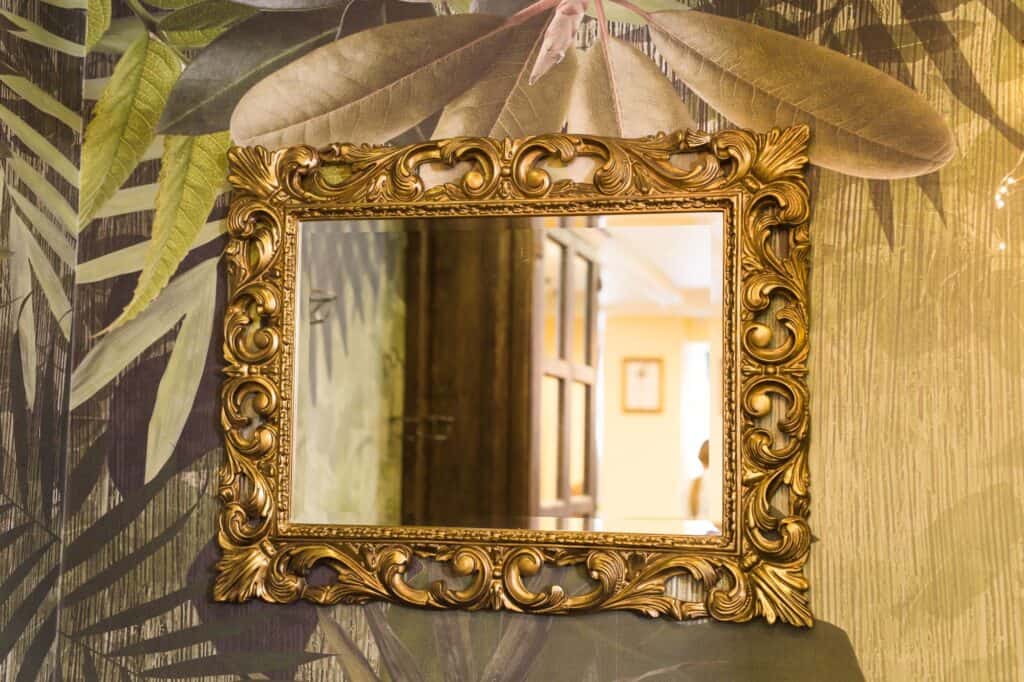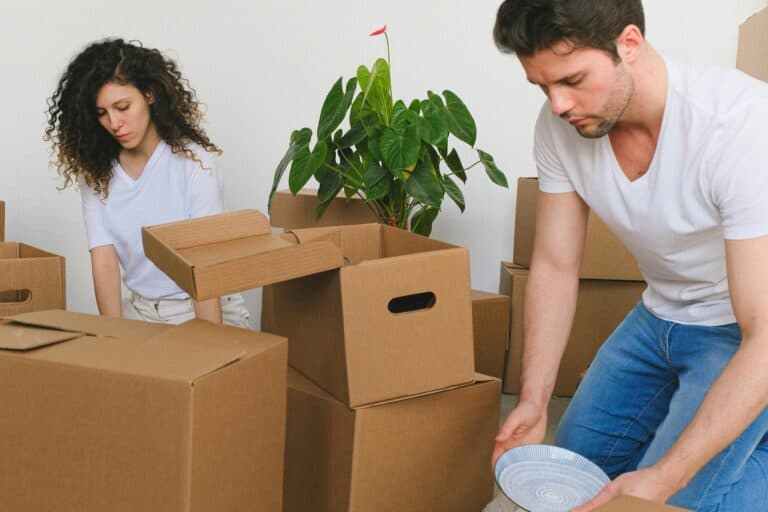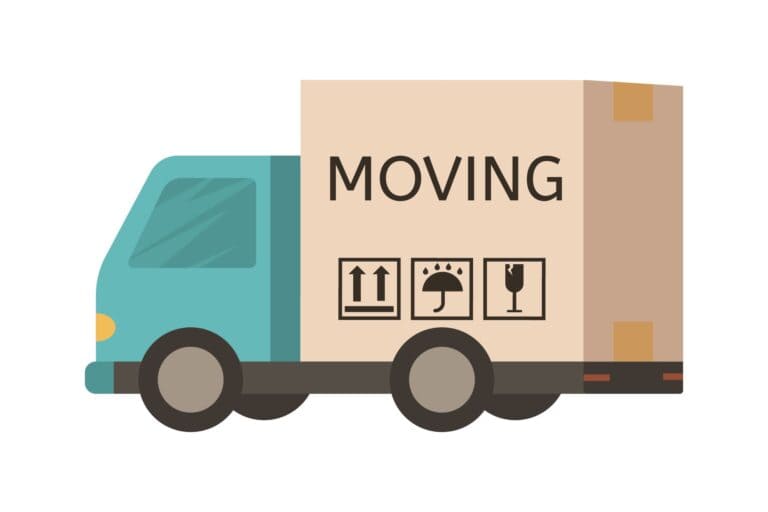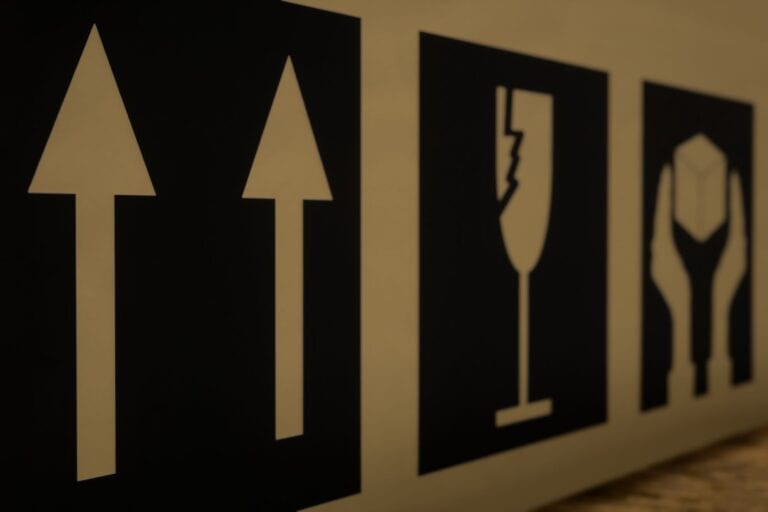When moving, packing fragile items effectively is essential to ensure your glassware, ceramics, and family heirlooms arrive intact. In this step-by-step guide on how to pack fragile items, we’ll cover the protective materials you’ll need and the best techniques to secure your delicate possessions. From selecting the right box to the final tape seal, we’ll help you pack with confidence.
Key Takeaways
- Use quality packing materials, including sturdy boxes, bubble wrap, and packing paper, and employ techniques like double-boxing and strategic cushioning to ensure the safety of fragile items during transit.
- Individually wrap and protect fragile items such as glassware, ceramics, picture frames, artwork, and electronics, and consider carrying extremely valuable items by hand for added security.
- Maximise space while protecting items by filling empty spaces with cushioning materials, arranging boxes with heavier items on the bottom and lighter items on top, and securing loose parts and wrapping large items carefully for transportation.
Gathering Essential Packing Supplies
The foundation of successfully packing fragile items lies in gathering the right arsenal of essential packing supplies for both delicate items and breakable items. Have you ever held your breath while opening a box, hoping that your delicate items survived the journey?
With high-quality protective materials like bubble wrap and packing paper, your fragile belongings will not only survive but thrive during travel. The key is to use sturdy corrugated cardboard boxes that show no signs of weakness; these boxes are your first line of defence in keeping your fragile glassware and ceramics safe and sound.
In the realm of packing delicate items, it’s not just about what you pack but how you pack. Think of bubble wrap and foam enclosures as the knights in shining armour for your fragile items, cushioning them and preventing any jostling during transit. It’s a dance of delicacy and strength, where the right packing materials ensure your treasured possessions are cocooned in safety, ready for their journey to your new home.
Choosing the Right Boxes for Your Fragile Belongings
The quest for the perfect box for your fragile items is akin to finding Cinderella’s glass slipper – it needs to be just the right fit. Smaller boxes are like the trusty sidekicks for heavy, fragile items; they’re more manageable and minimise the chances of items colliding with one another. It’s all about containment and control when it comes to packing fragile items, ensuring they’re snug and secure within their cardboard confines.
And when it comes to protection, why not double up? Envision double-boxing as the fortress walls around your most prized possessions. By placing your carefully packed smaller box within a larger one, you’re adding an extra layer of cushioning and security, safeguarding your beloved items from the perils of the move. It’s a simple step that can make a world of difference in keeping your fragile items safe and sound.
The Role of Packing Paper and Bubble Wrap
Staring down at your cherished ceramics and glassware, you might wonder how to best shield them from the bumps and grinds of moving day. Enter packing paper, the unsung hero that provides that essential initial layer of protection, wrapping each piece in a soft embrace to prevent scratches and damage. Imagine each piece of your tableware swathed in paper, like delicate flowers ready to be placed in a vase, ensuring their beauty remains unblemished upon arrival.
But why stop there? Just as a knight dons armour over his tunic, so should your fragile items be enveloped in packing paper and then bubble wrap. This dynamic duo acts as a shield against the jolts and jostles of transport, absorbing shocks and keeping your items in pristine condition. Secure them snugly with packing tape, and you’ll have peace of mind knowing that your treasures are ready for any bumps in the road.
Sealing with Confidence: The Importance of Packing Tape
The final step in the packing process is perhaps the most crucial one – sealing with confidence. Imagine the packing tape as your trusty squire, dutifully securing the edges and seams of your boxes. Heavy-duty packing tape doesn’t falter; it holds firm, ensuring that the contents of your carefully packed boxes remain in place from the first lift to the last set down.
Let the packing tape be the last line of defence, the seal that says, ‘Not on my watch!’ It’s the reassurance that when you pack fragile items, they are as secure as can be, ready to face the journey ahead without fear of opening or spilling their precious contents. With your boxes taped and true, your fragile belongings are set for a voyage as smooth as the tape itself.
Strategically Packing Delicate Items

The art of strategically packing delicate items is much like a game of chess – each move is calculated, and every piece is essential. Begin by turning hollow items like vases and jars into bastions of strength by using the technique to fill hollow items with packing paper, which acts as a buffer against vibrations and the risk of cracks. It’s about transforming potential weaknesses into fortified spaces, ensuring that the hollow becomes whole.
When it comes to the very delicate, like fine china, individual wrapping becomes a ritual of preservation. Each piece is swathed in bubble wrap, safeguarding against the roughest of roads and the sharpest of turns. Place these wrapped treasures separately in their boxes, with layers of protection between them to prevent any chance encounters that could lead to damage.
And for those items too precious to trust to the moving truck, consider carrying them with you, offering personal oversight that guarantees their safety.
How to Pack Glassware and Ceramics Safely
When it comes to glassware and ceramics, wrapping and stacking are your best strategies. Visualise each plate and bowl as a delicate discus, each one individually wrapped in packing paper or bubble wrap, then stacked and secured like a tower of strength. With glassware, the process is even more intricate – insert packing paper inside each glass, wrap the stems in bubble wrap, and secure them with the loving embrace of packing tape.
The use of cardboard dividers is akin to creating individual rooms for each glassware item, a special place where they can rest without fear of collision. And don’t forget the lining of the boxes – a combination of newspaper and bubble wrap layers that act as a soft bed for your glassware to nestle into. With these steps, you transform a box of potential disasters into a safe haven for your most fragile items.
Ensuring Safe Transit for Picture Frames and Artwork
Picture frames and artwork require a special touch, an understanding that beyond the glass lies memories and beauty that must be preserved. Start with a sandwich of protection – cardboard on the inner and outer layers, with bubble wrap nestled in between, providing a barrier as solid as the frames themselves. If the box feels too spacious, fill it with crumpled newsprint or packing paper, creating a snug environment that frames and artwork can call home during the move.
For added safety, consider specialised picture or mirror boxes designed to embrace and protect these items during their journey. It’s about creating a cocoon tailored to their shape and size, ensuring that your cherished pieces arrive at your new location as perfect as when they left your old one.
Special Considerations for Antique Furniture
Antique furniture demands extra care and attention, with each piece often carrying its own story and history. When possible, disassemble these treasures to reduce their vulnerability during the move. Here’s how to pack antique furniture for a move:
- Wrap each part in old towels or thick blankets, creating a soft, protective layer that guards against the adversities of travel.
- For added safety, swaddle the parts in bubble wrap.
- Secure everything with packing tape, ensuring that even the smallest details are shielded from harm.
By following these steps, you can ensure that your delicate or antique furniture arrives at its new destination in pristine condition.
When faced with odd shapes or sizes, seek out custom-sized boxing solutions that fit like a glove, minimising movement and maximising protection …
Sometimes, the standard boxes just won’t do. When faced with odd shapes or sizes, seek out custom-sized boxing solutions that fit like a glove, minimising movement and maximising protection during transit. It’s a thoughtful step that honours the unique nature of your antique furniture and promises a safe arrival at your new abode.
Maximising Space While Protecting Fragile Items
As we turn to the task of maximising space while keeping fragile items secure, it’s about striking a delicate balance. Choose a box that’s ever so slightly larger than the item itself, offering just enough room for the dance of padding without the chaos of excessive empty space. It’s a strategic move that allows for graceful movement within the box while ensuring that each item remains in its designated spot, safe from harm.
At the heart of this balancing act is the careful placement of cushioning materials. Packing peanuts, towels, or paper fill the voids, embracing your fragile items, and keeping them still as the world moves around them. And when sorting items within the box, remember the golden rule: heavy on the bottom to anchor the load, and light on top to float above harm’s way.
Filling Empty Spaces to Prevent Movement
Filling empty spaces within boxes is not just a matter of using space efficiently – it’s about creating a sanctuary for your fragile items. Cushioning materials such as packing paper, foam, and styrofoam peanuts are the unsung heroes of this sanctuary, providing the padding that protects your items from the bumps and jolts of the move. These materials are like the gentle hands that hold your items in place, ensuring that no matter the twists and turns of the road, your fragile belongings stay safe and secure.
For those who prefer a more sustainable approach, consider repurposing soft items like shirts and towels as packing material to fill any empty space within the boxes. This not only provides an additional layer of protection but also reduces waste and saves space. Remember to choose boxes with just enough extra room for these cushioning materials, as this will enhance the overall protection for your fragile items and ensure a peaceful journey to their new home.
Layering Strategy: Heavy on Bottom, Light on Top
The layering strategy in packing is crucial, much like the foundation of a building. Heavy items form the base, offering stability and protection for the lighter, more delicate items that will rest on top. It’s the wisdom of gravity at play, ensuring that the weight is distributed in a way that prevents crushing and maintains the integrity of each piece.
As you arrange items from largest to smallest, creating a pyramid of protection, it’s essential to review the packing process, ensuring that the heavy-on-bottom, light-on-top rule is followed to a tee. With dividers and careful wrapping, each fragile item is given its own place of honour within the box, nestled safely away from potential risks.
Securing Loose Parts and Cables
In the world of electronics, loose parts and cables can be the bane of a move. Begin by removing all leads, cables, and attachments, preparing them for their journey. Wrap these components in bubble wrap, turning them from potential hazards into secure travellers, safe from the jostle and jumble of the road.
Place these wrapped treasures in strong, sealable plastic bags, each labelled with the name of its corresponding electronic companion. This simple act of organisation not only prevents loss but also ensures a smooth reassembly at your new destination. Secure the wrappings with packing tape, and you transform a tangled mess into an orderly procession, ready for the moving truck.
Preparing Large Items for the Moving Truck

When it comes to the moving truck, large items demand a special kind of preparation. Think of wrapping your large electronic items as swaddling a baby; you want them to be protected, secure, and ready for the journey. The use of bubble wrap and bungee cords can turn even the bulkiest of electronics into a package primed for safe travel.
With heavy items forming the sturdy base of your load, you create a foundation as solid as bedrock. This strategy not only safeguards your large items but also creates a protective layer for the smaller, more delicate treasures that will be placed on top, ensuring they are cushioned from the pressures of the move.
Wrapping Techniques for Large Electronics
Large electronics such as TVs and monitors are like the crown jewels of your electronic collection, deserving of the utmost protection. Start by wrapping these items in bubble wrap, taking care to cover every inch of their surface, especially the screens, to guard against any potential harm. Then, wrap them further in a towel or blanket, providing an additional layer of defence against the unexpected.
Once fully wrapped, place the electronics in a cardboard box that’s just the right size, filling any extra space with packing peanuts to keep them from shifting during the move. Secure the wrappings with bungee cords or tape, ensuring that everything stays in place no matter the bumps along the way.
Protective Measures for Mirrors and Glass Tabletops
Mirrors and glass tabletops are the delicate dancers of the furniture world, moving gracefully but with inherent fragility. Begin by wrapping them in two layers of moving blankets secured with rubber bands, followed by a cocoon of bubble wrap, securely taped to ensure they remain intact. This protective measure is like creating a suit of armour tailored to shield against any potential threats during transport.
For mirrors and glass tabletops, consider giving them their special packaging. Here’s how:
- Place them in a custom-fitted box or create a protective sleeve using a larger, collapsed box. This extra 30% of space offers a cushion against any pressure that might otherwise compromise their integrity.
- Remember to store these items on their edges, not flat, to prevent cracking.
- Label them clearly with warnings to handle with care. By doing so, you nestle these items safely between heavier objects in the truck, ensuring they remain secure and undamaged throughout the move.
Final Checks Before Moving Day
As moving day approaches, take a moment for final checks to ensure your fragile items for moving are ready for their journey. Each box should be labelled with a resounding ‘fragile’ to encourage careful handling and correct placement upon arrival at your new location. It’s like placing a gentle reminder for those handling your belongings that inside lies something precious and irreplaceable.
Perform a comprehensive room-by-room sweep to confirm that all fragile items have been accounted for, properly packed, and labelled accurately. It’s a final act of vigilance, akin to a captain surveying their ship before setting sail.
For those items of exceptional value, consider packing them separately and, if possible, carry them by hand to ensure their safety and your peace of mind.
Reviewing Box Labels and Placement
The labels on your boxes are more than mere markers; they’re the roadmap for a smooth transition to your new home. Ensure that each box containing fragile items is boldly marked with ‘Fragile’ to alert your Islington movers and helpers to the need for gentle handling. Additionally, label boxes with their contents and the designated room at the new house, creating an organised system that eases the unpacking process.
Clear directions such as ‘This Way Up’ on the boxes help ensure proper transportation and placement, avoiding any unnecessary shifts that could lead to damage. Don’t hesitate to communicate directly with your moving team, reinforcing the importance of proper placement and handling of your fragile items. This personal touch can make all the difference in ensuring your items arrive safe and sound.
Double-Checking Padding and Seals
Before sealing the fate of your fragile items, double-check that each one is snugly wrapped and immobilised with padding to protect against shocks and vibrations during the move. It’s like tucking your belongings in for a long trip, ensuring they’re comfortable and secure. Verify that the bubble wrap and packing peanuts are properly applied, leaving no empty spaces within the boxes that could allow for damaging movement.
Inspect the integrity of the box seals, ensuring that the heavy-duty packing tape has been firmly applied and is ready to hold up against the pressures of transport.
NOTE
The final comprehensive review is like a captain’s last inspection before departure, a crucial step to confirm that all is in order and that your fragile items are safeguarded throughout the moving process.
Summary
As we wrap up our guide, you’re now equipped with the knowledge and confidence to pack and transport your fragile items safely. From selecting the best packaging material to ensuring the secure transit of your delicate treasures, you’ve learned the top tips for a successful move. Embrace this new beginning with the assurance that your cherished belongings will arrive at your new house as intact and full of memories as when they left your old one. With these strategies in hand, you’re ready to turn the page to the next chapter in your life, knowing your fragile items are packed with care.
Frequently Asked Questions
What’s the best way to pack glassware to prevent breakage?
The best way to pack glassware and prevent breakage is to individually wrap each piece with packing paper, insert paper inside the glass, wrap the stems with bubble wrap, and use cardboard dividers within boxes to keep each piece separated and protected. This will ensure that the glassware stays safe during the move.
Can I use towels and clothing instead of packing paper for cushioning?
Yes, you can use towels and clothing to fill empty spaces in boxes as a protective and eco-friendly option.
Should I pack my flat-screen TV in a box during the move?
Yes, you should pack your flat-screen TV in a box during the move to ensure its safety and protection. Be sure to use bubble wrap, a towel or blanket, and packing peanuts for extra cushioning.
How do I ensure my picture frames and artwork are safe during transit?
To ensure your picture frames and artwork are safe during transit, wrap them with cardboard on the inner and outer layers, place bubble wrap in between, use picture or mirror boxes, and fill any loose spaces with packing paper to prevent movement.
What should I do if my antique furniture can’t be disassembled before moving?
To protect your antique furniture during the move, wrap it in old towels and thick blankets, add a layer of bubble wrap, and secure everything with packing tape for added protection. Custom-sized boxing solutions can also be considered.








